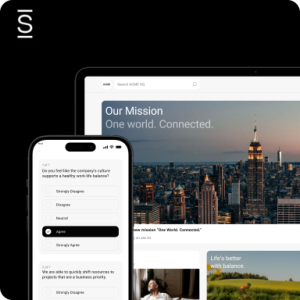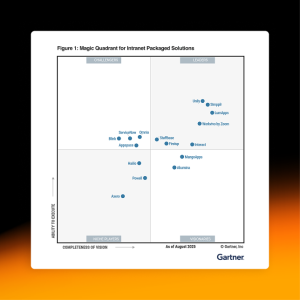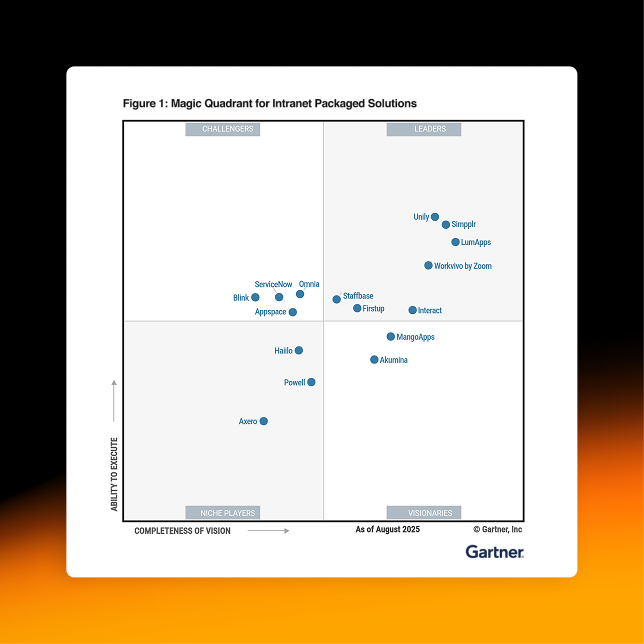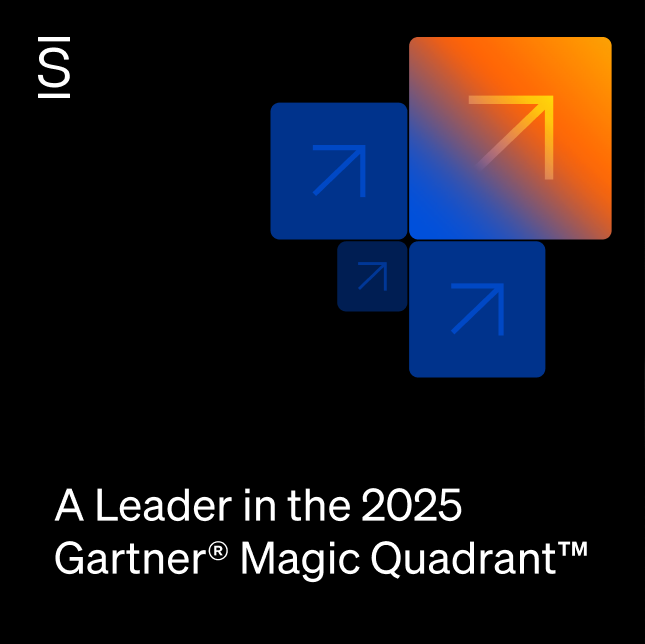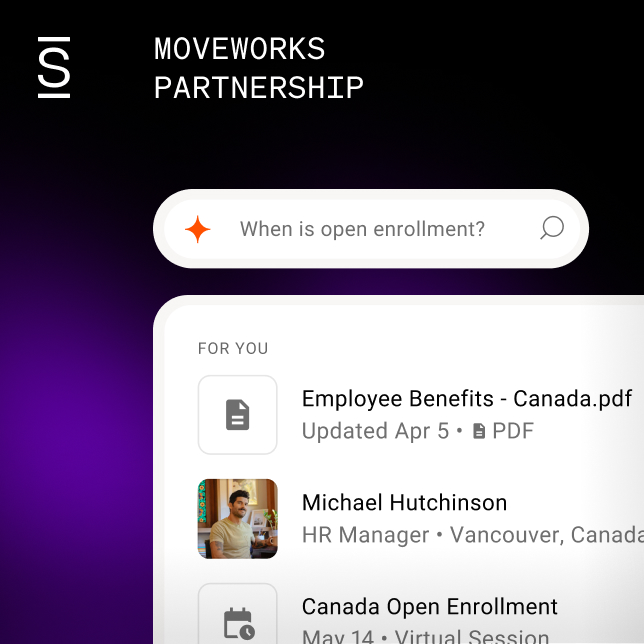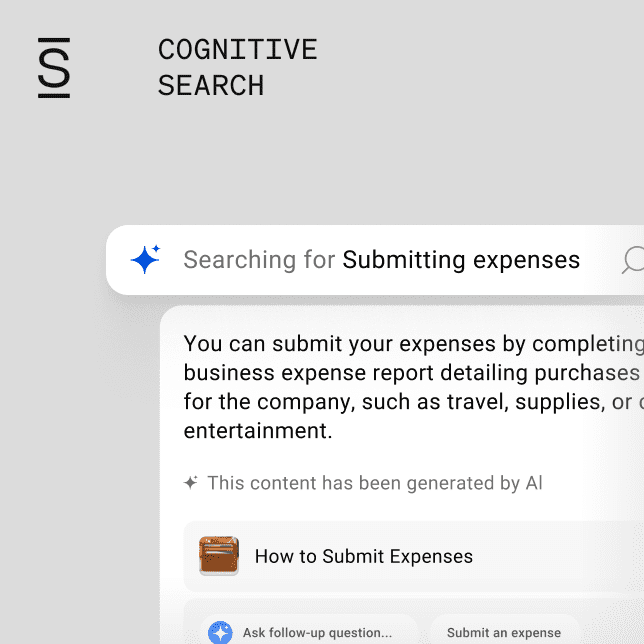Cognitive search definition
Cognitive search is an advanced search technology that uses artificial intelligence (AI) to quickly find relevant and accurate search results for various types of queries.
Modern enterprise systems store information, such as manuals, FAQs, research reports, customer service guides, and human resources documentation, across various scattered systems. Unlike traditional search that matches keywords, cognitive search scans databases and understands the context, intent, and natural language behind queries to deliver highly relevant, personalized results.
This intelligent approach leverages natural language processing (NLP), machine learning, and semantic analysis to interpret user intent, even when queries are phrased conversationally or use synonyms and related terms.
For instance, when a user searches for “quarterly sales performance,” cognitive search doesn’t just match those exact terms — it understands the intent and may provide sales reports, revenue analytics, team performance metrics, and related strategic documents, even if they use different terminology.
It incorporates features such as auto-complete suggestions, faceted filtering, result ranking based on relevance and user behavior, and the ability to surface insights from unstructured data (including text documents, images, audio files, and videos). This bridges the gap between how humans naturally ask questions and how information systems traditionally operate. Cognitive search enables more intuitive and efficient information discovery, ultimately improving productivity and decision-making across enterprise environments.

Key components of cognitive search
Cognitive search uses four core components that work together to deliver intelligent results.
Natural language processing for human-like query understanding
Natural language processing, or NLP, understands queries the way people naturally communicate. This capability allows users to search using natural phrases like “Show me last quarter’s sales reports for the Northeast region” rather than constructing keyword combinations. It recognizes synonyms, handles typos and variations in terminology, and can even interpret queries with missing or implied information.
It helps the system:
- Understand the intent behind the query
- Recognize synonyms and related terms
- Break down complex questions into meaningful parts
- Handle typos, slang, or incomplete phrases
- Does sentiment analysis to understand the tone of the text (positive, negative, or neutral)
Machine learning algorithms that improve over time
Machine learning algorithms analyze patterns in user behavior, content relationships, and organizational information flows to predict what users actually want to find.
The learning happens at multiple levels. Click-through patterns reveal which results users find most valuable for specific query types. The time spent reading documents indicates the quality and relevance of the content. Search refinements highlight where initial results fell short, offering feedback that enhances future responses.
This continuous learning creates a feedback loop where the system becomes more accurate and personalized over time.
Contextual understanding across multiple data sources
Contextual understanding is what sets cognitive search apart from traditional search tools. In most organizations, valuable information is scattered across various systems, including the intranet, document management platforms, cloud drives, HR tools, help desk software, and even email threads.
Cognitive search scans large databases of disparate information and utilizes AI to interpret not only what the user types, but also what they mean. It understands context, recognizes synonyms, and pulls together relevant content — regardless of where it’s stored or how it’s labeled.
Intent recognition and predictive search capabilities
Intent recognition allows cognitive search to understand the purpose behind queries. This capability distinguishes between informational searches (“What is our vacation policy?”), navigational searches (“Find the employee handbook”), and action-oriented searches (“Submit an expense report”).
Predictive capabilities anticipate information needs based on current context, user roles, calendar events, and organizational activities. For instance, while onboarding new employees, it could automatically recommend training materials and policy documents.
How does cognitive search work?
The technology powering modern cognitive search represents a significant departure from the boolean logic and keyword matching that defined how people should search. The old search approach worked reasonably well for straightforward queries but broke down when users asked complex questions or couldn’t remember exact terminology.
Here’s how cognitive search processes work:
- Query interpretation: Natural language processing breaks down search queries to identify key entities, understand grammatical structure, and determine user intent. The system analyzes the meaning behind the words and phrases rather than treating them as keywords.
- Contextual analysis: The system then analyzes who is searching and when. It checks the user’s role (sales manager vs. finance director), current projects, recent document activity, and organizational context.
- Semantic matching: Semantic understanding algorithms identify conceptually related content beyond exact keyword matches. The system recognizes synonyms, related terms, and thematic connections between different pieces of information stored across various repositories.
- Content scoring and ranking: Machine learning algorithms evaluate each piece of content based on relevance, recency, user permissions, and predicted usefulness. The system weighs factors such as document authority, the similarity of users’ interactions with content, and the relevance to current business priorities.
- Result compilation: Includes primary documents, related content, collaborative discussions, and supporting materials. It identifies connections between different information sources and groups related content for easier discovery.
- Personalized delivery: Results get tailored based on individual user profiles, access permissions, and role-specific information needs. The system prioritizes content most relevant to specific responsibilities while filtering out information outside the user’s scope of work.
- Learns and implements: The system tracks which results users click, how long they spend reading documents, and whether they refine their searches. This feedback continuously improves future query processing and result ranking for similar searches.
How cognitive search differs from other search technologies
Organizations often get confused between cognitive search and related technologies. While these approaches share some similarities, they serve different purposes and offer distinct capabilities. Understanding these differences helps IT leaders choose the right technology mix for their specific information discovery needs.
Cognitive search vs enterprise search
Traditional enterprise search focuses on indexing and retrieving documents across multiple repositories using keyword matching. It finds specific documents when users know exact terms or phrases. Cognitive search builds upon this foundation but adds AI-powered understanding of user intent, context, and natural language queries. While enterprise search returns documents containing keywords, cognitive search interprets what users actually want to accomplish and delivers contextually relevant results.

Cognitive search vs retrieval augmented generation (RAG)
RAG combines information retrieval with generative AI to create new content based on existing documents — producing summaries, answers, or synthesized reports. It focuses on generating responses rather than surfacing original source materials. Cognitive search concentrates on finding and organizing the most relevant existing information based on user context and intent. RAG works best for creating custom content, while cognitive search excels at discovering and accessing original documents and data for detailed analysis.
Cognitive search vs semantic search
Semantic search understands the meaning and relationships between concepts using techniques like vector representations and knowledge graphs. It identifies that related terms refer to similar concepts, but operates primarily at the content level. Cognitive search incorporates semantic understanding as one component within a broader AI framework that also includes user context, behavioral patterns, and organizational knowledge. Semantic search focuses on conceptual relationships, helping identify meaning across documents based on conceptual similarity rather than exact keywords.
Cognitive search vs knowledge graphs
Knowledge graphs create structured maps of how information connects — linking people, places, concepts, and relationships in a web-like database. When integrated into cognitive search, it enhances context-awareness and recommendation accuracy.
Cognitive search uses AI to infer relationships and context dynamically from existing content without requiring pre-structured data models. Knowledge graphs provide explicit structure, while cognitive search discovers connections through content analysis and user behavior patterns.
Cognitive search vs knowledge AI
Knowledge AI automatically organizes content, creates workflows, and predicts knowledge needs across all business processes. However, cognitive search focuses specifically on information discovery and retrieval as one component within knowledge AI ecosystems. Knowledge AI manages the entire knowledge lifecycle, while cognitive search optimizes the discovery and access layer.
Benefits of cognitive search
Traditional search often falls short when information is buried across tools and systems. Cognitive search solves this by using AI to understand queries in context and return precise, actionable results:
- Improved productivity: Quick access to information directly impacts employee productivity. According to a Gartner survey of 4,861 full-time digital workers conducted in late 2022, 47% reported difficulty finding the information needed to effectively perform their jobs. This leads to delayed decision-making, reduced efficiency, and hampers overall productivity.
Simpplr’s cognitive search prevents this issue by delivering personalized, secured answers embedded into each employee’s digital workspace. With AI-powered capabilities, employees can get the information on time, even if the exact keywords aren’t present.
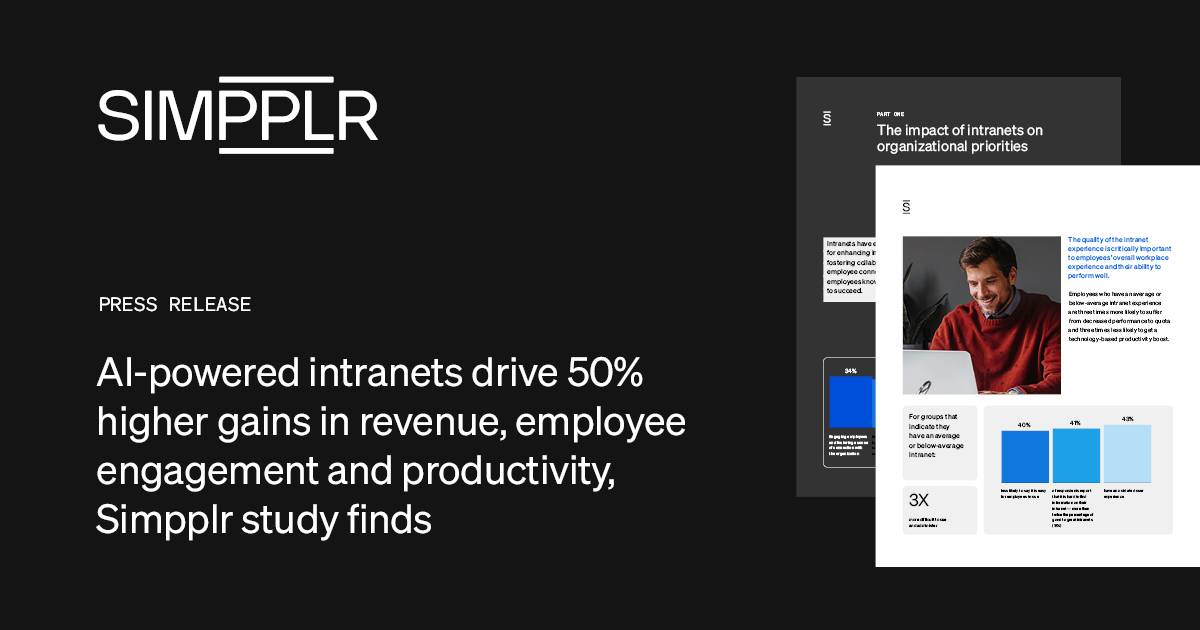
- Breaks down information silos: In most organizations, knowledge is scattered across various platforms like SharePoint, Google Drive, Slack, email, and project management tools. Different teams often describe the same concepts in different ways, leading to inconsistencies, duplicated efforts, and missed insights.
Cognitive search unifies these fragmented sources by understanding context and meaning, making information easily discoverable — regardless of where or how it’s stored. This reduces inefficiencies, improves cross-functional collaboration, and helps businesses operate more intelligently. - Enhanced search experience: Poor search experiences can create cumulative frustration, affecting overall job satisfaction and workplace productivity. When employees can quickly find the information they need while having a smooth user interface, their relationship with organizational systems improves, and they’re more likely to engage fully with digital workplace tools.
- Faster decision-making: Quick access to comprehensive and relevant information enables faster and more informed decision-making at all organizational levels. When executives can instantly access performance data, market research, and operational insights, they can respond more quickly to opportunities and challenges.
- Personalized search results: Cognitive search provides a personalized employee experience by delivering customized and relevant responses that meet specific needs, taking into account the employee’s location, department, and other relevant attributes. For instance, a sales rep and an HR manager searching for ‘onboarding’ may see entirely different results — each aligned with their specific responsibilities and context.
- Reduced complexity: For IT leaders, a powerful cognitive search platform can reduce complexity and streamline technical operations, while improving employee experience. When integrated with the right intranet solution, cognitive search can reduce the volume of IT tickets, minimize time spent on repetitive queries, and free up resources for more strategic initiatives. It also simplifies system maintenance by automatically indexing and organizing data across tools.
Build rich search experiences with Simpplr cognitive search
Most intranet platforms follow a traditional search method. This becomes a frustrating trial-and-error process where employees waste time guessing the right keywords, searching through irrelevant results, and often giving up their search entirely without finding what they need.
That’s why Simpplr, the leading AI-powered EX platform, embeds cognitive search at the core of a modern intranet experience. By unifying employee engagement, enablement, and services, Simpplr transforms how organizations access information. Its capabilities have been recognized by Forrester Research in the Cognitive Search Platforms Landscape, Q2 2025 report.
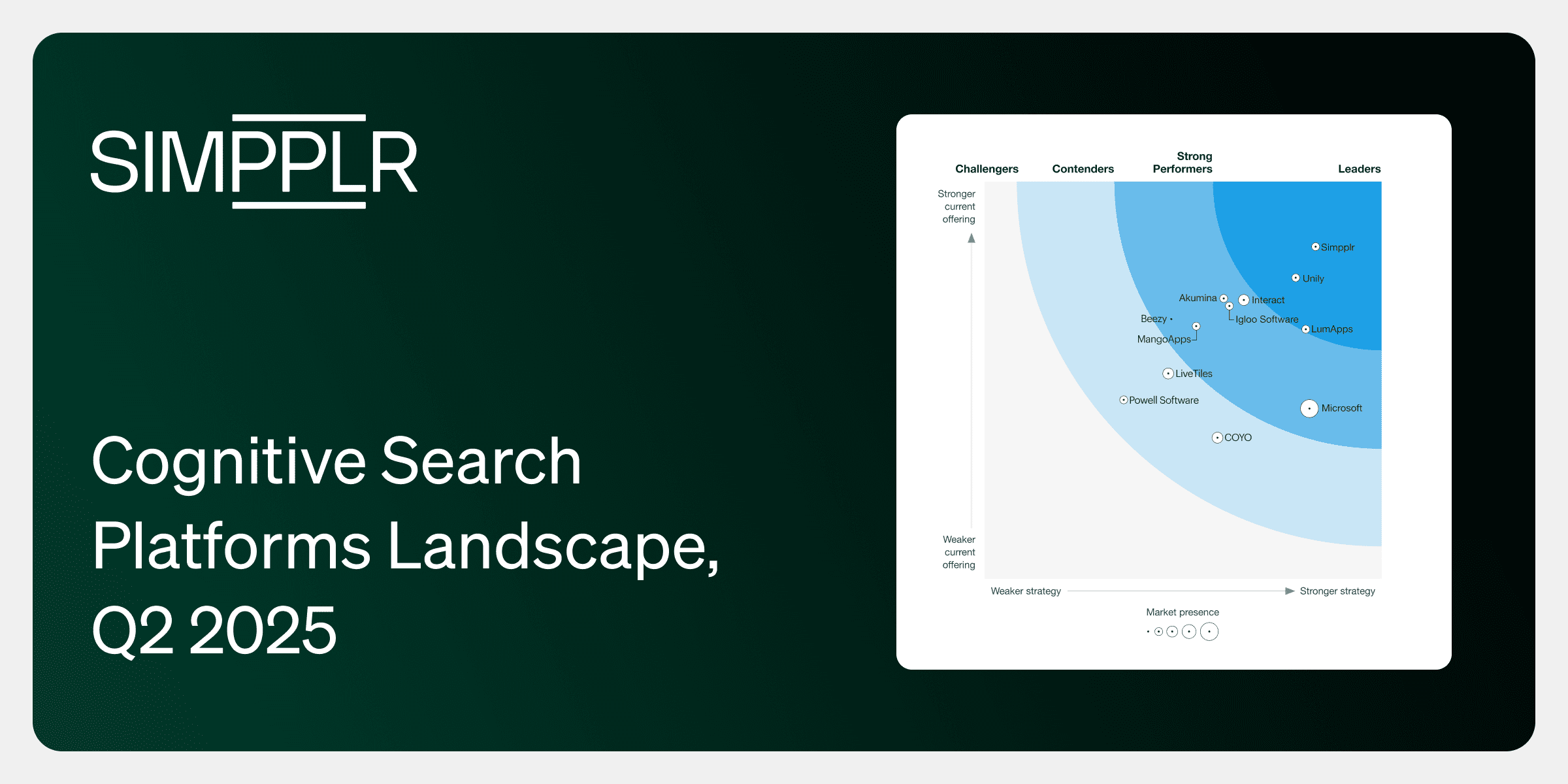
Simpplr’s inclusion in the cognitive search report validates its capabilities and provides immediate benefits while creating the infrastructure for future agentic AI applications that can take action based on discovered insights.
Simpplr’s native cognitive search capabilities include:
- Built-in enterprise search with advanced capabilities like semantic understanding, vector search, and retrieval-augmented generation (RAG)
- Unified access to both structured and unstructured data across cloud platforms such as Google Drive, SharePoint, ServiceNow, and Confluence
- AI-powered, personalized answers and action suggestions delivered within each employee’s digital workspace — fully aligned with permissions and context
- Scalable foundation for agentic AI, enabling organizations to evolve from smart search to automated workflows
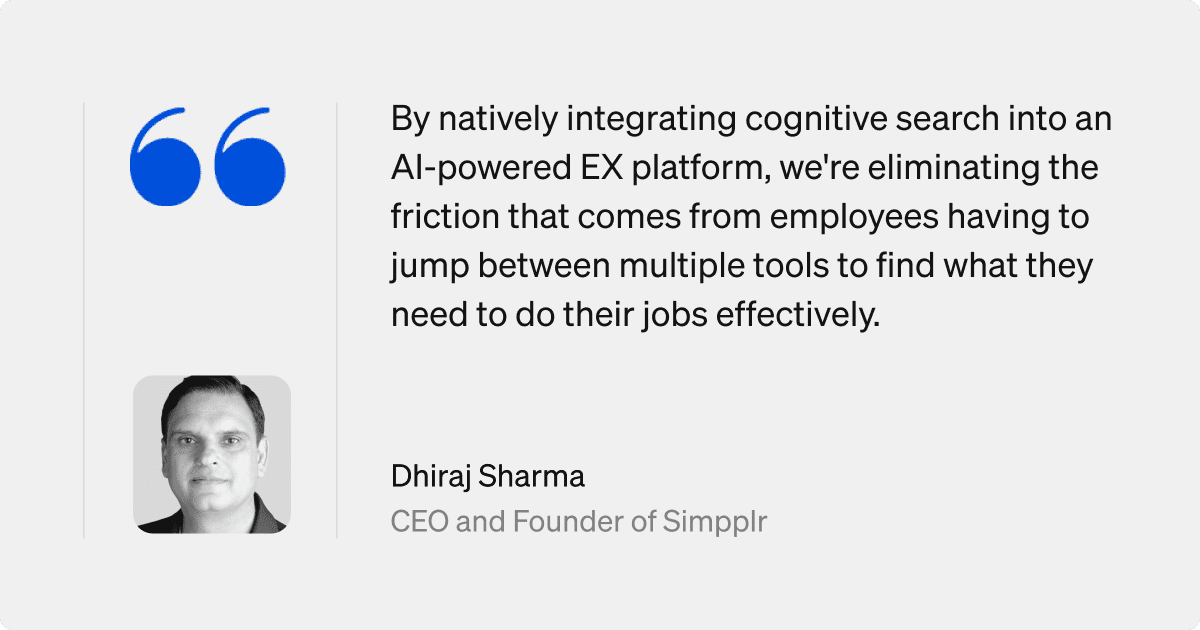
With these capabilities, search improves over time through continued use and feedback, delivering increasingly personalized and accurate results that anticipate user needs rather than simply responding to keyword inputs.
Ready to transform your organization’s approach to information discovery? See why Forrester recognized Simpplr in the Q2 2025 Cognitive Search Platforms Landscape.
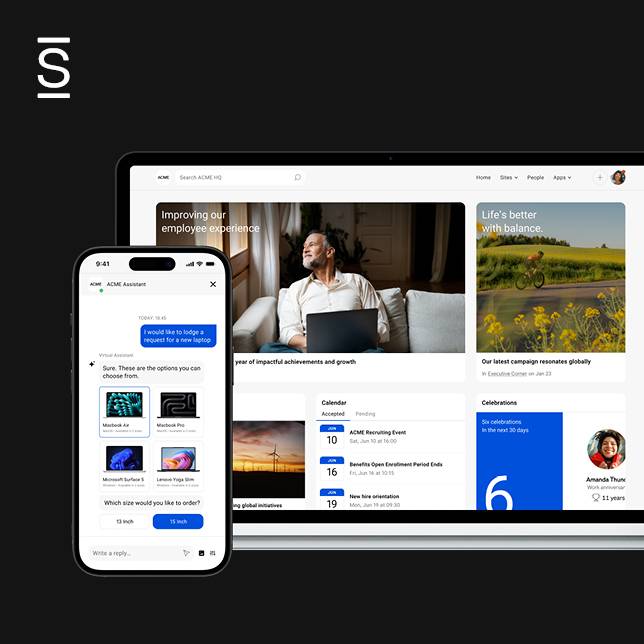
Watch a 5-minute demo
See how the Simpplr employee experience platform connects, engages and empowers your workforce.
- #1 Leader in the Gartner Magic Quadrant™
- 90%+ Employee adoption rate


